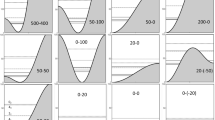Abstract:
We find relative equilibria (RE) of the rotating and vibrating tetrahedral molecule P4 and study the correspondence of these RE's to the extremal quantum states in the vibration-rotation multiplet and to the extrema of the semi-quantum rotational energy surfaces obtained for a number of excited vibrational states. To compute the energy of RE's we normalize the full rotation-vibration Hamiltonian H of P4 in the approximation of nonresonant modes ν E 2 and ν F_2 3 and find the stationary points of the resulting normal form (known as reduced effective Hamiltonian H eff ) which is defined on the reduced phase space CP 2 × CP 1 × S 2 . Most of these points are fixed points of the symmetry group action on CP 2 × CP 1 × S 2 . To explain our results in more detail we introduce numerical values of the parameters of H, such as the cubic force constants, using an atom-atom harmonic potential with one adjustable parameter. This simple model gives correct qualitative description of the rotational structure of the lowest excited vibrational states ν 2 , ν 3 and ν 2 + ν 3 of P4.
Similar content being viewed by others
Author information
Authors and Affiliations
Additional information
Received 30 March 2001 and Received in final form 22 June 2001
Rights and permissions
About this article
Cite this article
van Hecke, C., Sadovskií, D., Zhilinskií, B. et al. Rotational-vibrational relative equilibria and the structure of quantum energy spectrum of the tetrahedral molecule P 4 . Eur. Phys. J. D 17, 13–35 (2001). https://doi.org/10.1007/s100530170033
Issue Date:
DOI: https://doi.org/10.1007/s100530170033




